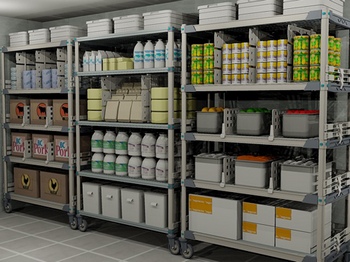When it comes to operating a restaurant or any commercial foodservice kitchen, owners and managers understand the responsibilities and challenges in proper food handling. From transport to the tabletop our food supply freight travels hundreds of miles rain or shine from sea to shining sea, or across the fruited plain. As a consumer who loves to eat, I rarely think about food handling when it’s on my plate. I trust everyone did their job!
Thanks to excellent highways and transportation technology, food quality and food safety awareness are excellent overall. So have food, it will travel! But are you, the owner/operator, ready to do your part to ensure that nothing but the BEST will do for your customers.
 The first line of defense in preventing foodborne illness is to obtain food from a reliable source. Whether ordering from a national supplier or buying local from the farmer’s markets, food safety begins with a trusted supplier.
The first line of defense in preventing foodborne illness is to obtain food from a reliable source. Whether ordering from a national supplier or buying local from the farmer’s markets, food safety begins with a trusted supplier.
The second line of defense is a properly trained staff that has an eye for detail and processing food quality and inventory count. A moment of truth begins when the truck arrives and your staff engages with the delivered order. Food quality demands thorough inspections at the time of receiving. All shipments must be inspected immediately and checked for:
- Proper temperatures – Typical refrigeration trucks are set at 40 degrees and freezers are set at zero. It never hurts to check temps with the driver and snoop around the gauges and document any issues on the receiving tickets.
- Intact packaging – Check date codes on packaging to ensure that only the freshest foods and ingredients enter the kitchen. Check again when moving products to walk-ins and dry storage. Rotate inventory and discard dated food products.
- Spoilage – Train receiving staff to inspect meats and produce for foul odors and discolorations. Along with checking date codes inspect packaging that is wet and torn as this may be an indication of fluctuating travel temperatures or spoiled foods. Packaging and labels should be clean; Easy to handle, Easy to read. The label should be attached to the product packaging and legible, not laying on the floor of the truck.
 Once foods are received and in good order, food storage needs to be acted on immediately. Remember foods are perishables and temperatures sensitive so the sooner it can be stored the better. Make food storage your third line of defense in your food safety plan. Evaluate your walk-in refrigeration and freezers for proper temperatures to optimize freshness and to avoid fluctuations in temperatures that may thaw frozen products or freeze refrigerated products. Place products on shelves that allow air to flow around shelving and case packs of products. This will protect against food spoilage from an overstocked shelf.
Once foods are received and in good order, food storage needs to be acted on immediately. Remember foods are perishables and temperatures sensitive so the sooner it can be stored the better. Make food storage your third line of defense in your food safety plan. Evaluate your walk-in refrigeration and freezers for proper temperatures to optimize freshness and to avoid fluctuations in temperatures that may thaw frozen products or freeze refrigerated products. Place products on shelves that allow air to flow around shelving and case packs of products. This will protect against food spoilage from an overstocked shelf.
Another consideration is cross-contamination. This typically occurs from case packs leaking or dripping onto other stored products. Avoid this by keeping meats low on the shelf and seal up storage containers. Clean and sanitize any areas where spills are detected and be sure to wash hands when the job is complete.
Food safety and food quality should be viewed as one and the same. Education and training will bring awareness and consistency that protects the consumer from ever experiencing a foodborne illness. For more detailed information regarding this topic check with your local health department who will help you to establish a process for food safety and handling. Proper receiving and storage temperatures are key to food quality and safety. Make it your best practice to set up your lines of defense.

